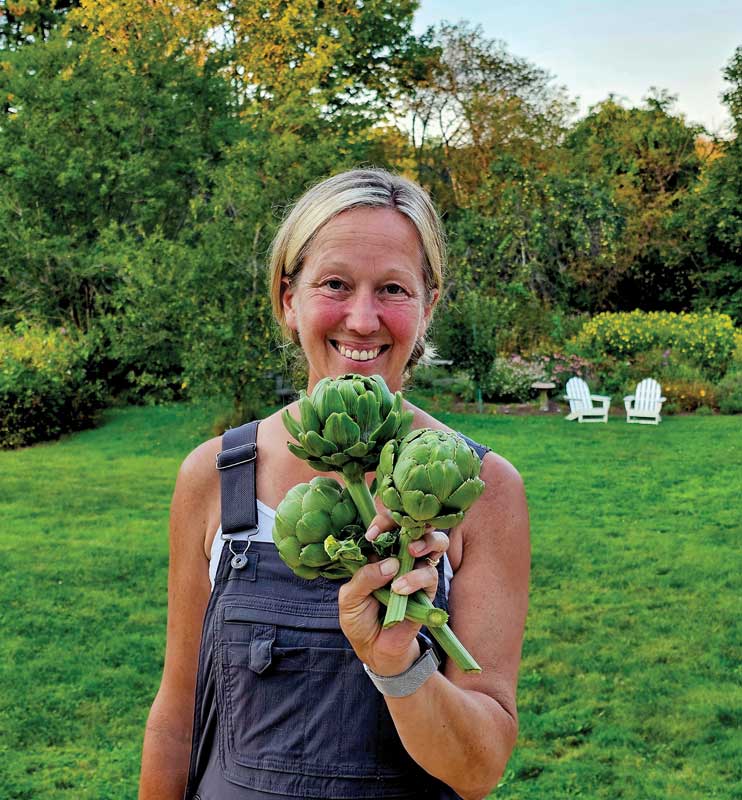
Three Bird Farm in Rockland is an unexpected gem in an unlikely spot, at least in the modern world. The
elegant 1800s farmhouse and iconic red barn sit on a lush four-acre parcel on Cedar Street, just a short walk from Rockland’s lively and culturally rich downtown. The property is teeming with plantings, and an elegant stone wall faces the street.
“The soil is really great here,” said Ret Talbot, who owns and operates Three Bird Farm alongside his wife, artist Karen Talbot, who is world-renowned for her masterful, largely fish-focused artwork that is both decorative and scientific. Notably, Karen is the artist behind “The Angler’s Pint,” which is glassware stocked by Orvis. Her gallery occupies a space in their farmhouse and is close enough to the village to be a popular destination on Rockland’s monthly First Friday Art Walk. Her slogan, emblazoned on the tasteful sign that hangs outside their home, is “Conservation through appreciation.”
Ret, a science writer, and Karen moved from Southern California to Maine in 2012 when their beloved Laguna Beach rental—once home to a brothel—went on the market. Although their California landlord offered them first refusal to purchase the home, the couple declined. Still, they had loved their time there. In a recent visit to the farm, they described walking to a hugely popular Laguna Beach artists’ market where Karen had an annual residency, and transforming their lawn into a landscape of culinary and otherwise intentional plantings.

“We turned the whole driveway into gardens,” Ret said as Karen nodded along with a smile. They explained that while there, they had begun trading pepper plants with other enthusiasts.
They stayed in their Laguna Beach bungalow for one final summer, finishing out Karen’s season at the artisan market and making a plan for their next adventure.
“It was opened up to the nation,” they said of their housing search. They made a list of criteria and lined the floor of Karen’s California studio with one-sheet descriptions of available properties nationwide that might fit the bill. They narrowed it down to about a dozen and Karen flew out to begin in-person tours, then Ret joined her a short time later. The exploration would ultimately land them in Rockland, where they now operate the gallery and farm, and where they keep heritage breed silver
appleyard ducks and grow a variety of fruit trees.
Their gardens, however, are where much of the magic happens. The Talbots have been heirloom seed and cultivar enthusiasts since their left-coast days. Each spring they grow approximately 1,000 seedlings, representing some of the rare, diverse, and exotic varietals that they enjoy and that they have honed over more than a decade of trading seeds and seedlings with enthusiasts and experts from all over the country.
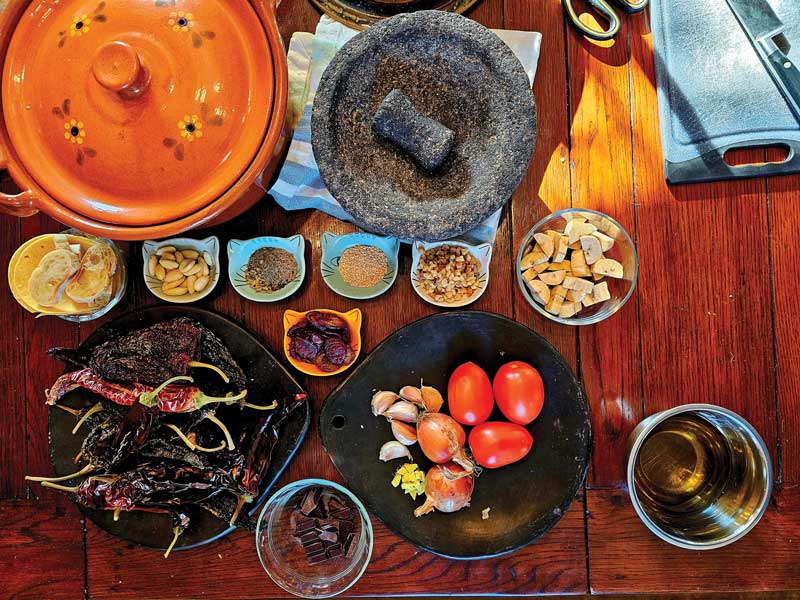
It’s easy to imagine that Almon Bird, who the Talbots believe began farming at the Cedar Street property during the last quarter of the 19th century, would be pleased with the Talbots’ stewardship.
The majority of the seedlings the Talbots grow are offered to the public in a much-anticipated seedling sale that takes place annually over the course of two weekends in late May.
This is a seedling sale that people wait for, with dozens of varieties of peppers, tomatoes, artichokes and more, including many that are difficult to find and rarely seen at such events. Largely though, the Talbots grow what they like. Ret said that much of what they plant and focus on is dictated by what they enjoy cooking and eating.
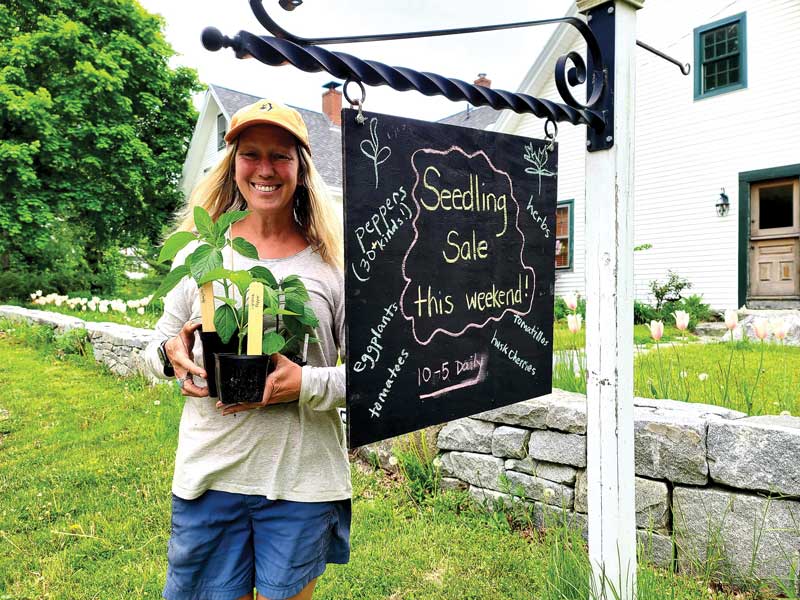
“We’ve always grown things,” Karen said. “We were super excited to see what the growing season was like here.” She added that education and experimentation have always been a part of their approach to gardening. “We are enthusiastic about heirloom varieties and preserving genetic diversity,” she said.
It was during the first year of the COVID pandemic that they “really stepped up” what they were doing in terms of self-sufficiency. “We wanted to be more self-sufficient and people wanted seedlings,” Ret said. “We did a lot of bartering during the pandemic.”
The Talbots said that the pandemic encouraged them to focus on their homestead.
“We hunkered down and turned more and more of the property into gardens and food production,” Ret said. The seedling sale was officially born in 2021.
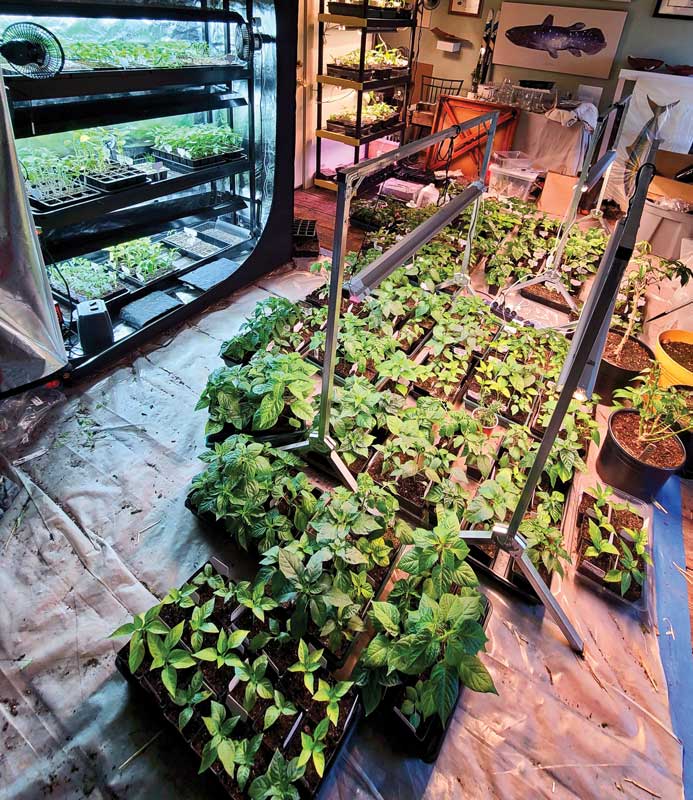
Karen said that they prefer to trial each variety before they sell it to the public. A former educator, Karen said she likes to set people up for success. “I am passionate about education,” she said. “I think some of that passion for teaching comes back with the seedlings.”
Ret said the popularity of the seedling sale is partially dictated by the weather. This year, he noted they heard many were eager to begin planting in mid-May as hints of beautiful weather emerged. But he said that 2025 is likely to be slightly slower than average in terms of seedling sales. On a banner year, “it can be a very busy two weekends,” Ret said, with an average of approximately 50 gardeners stopping in per day to peruse the enticing selection of young plants.
For Ret, the focus often turns to peppers. He is passionate about the abundance of rare and complex varieties and has plugged into a community of like-minded growers. He grows several Peruvian varieties and some of the “ultra-rare” super-hot varieties.
Among his reliable favorites is the canoncito, a pepper varietal from New Mexico that is acclimated to 7,000 feet.
“They do incredibly well here,” he said of the canoncitos. “For me with the peppers, I trade seeds with people all over the place, I am always looking for things that will do well here.”
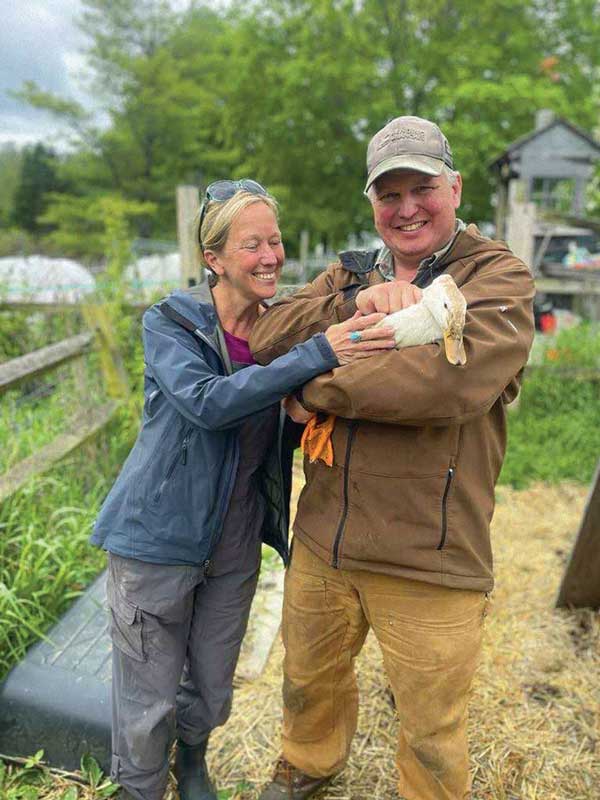
During the late summer and early fall, the Talbots said their smoker is going “constantly,” and they make jams as well as products using dried and smoked peppers. Ret cooks for all of Karen’s art workshops and makes garden-driven bites or cocktails for visitors to enjoy during each monthly Art Walk. They added that the Art Walk typically attracts dozens of visitors to Karen’s gallery on the farm.
One of the feats of logistics that the Talbots perform annually to facilitate the seedling sale is transforming Karen’s gallery space into a plant nursery. This requires meticulous care of the artwork that otherwise appears there, as a full swap is executed. For several months, lighted grow racks line the space as seedlings mature in anticipation of the big event in May. On the backside, the Talbots said they repaint the gallery annually, freshening it for a new season and erasing the evidence of its winter use—that is, until the magical cycle of the seasons calls for a repeat of the process.
Ret said they have faithful customers who will drive from all over New England to obtain that special seedling or pick-up a curated preorder, but many of the people they see annually are local.
“The local following is about great, garden-variety stuff and healthy seedlings,” Ret said. “People come back year after year.”
✮
Jenna Lookner is a freelance writer living on Little Deer Isle, where she and her husband raise heritage breed geese and chickens. A Camden native, she enjoys sharing the diverse stories of Maine’s people and places.






